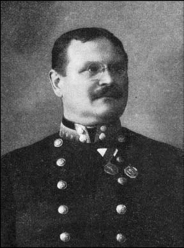- PACHNER
- AUSTRIA (see also List of Individuals)\
 .. 1865 Leitmeritz/CR - 24.9.1915 Praha/CR\Rudolf Pachner originated from the Aussig province, originally an Imperial Austrian region, today's Litomerice close to the German border in the Czech Republic. After graduation as a civil engineer from the Technical University in Prague, he joined the Bohemian public works service in 1889. Pachner raised the ladder of the service up to Baurat, and was stationed at cities such as his hometown, Carlsbad and finally in Prague from 1903, where he was an expert in hydraulic questions.\Pachner's specialization was hydrologic and hydro-technical approaches directed to the understanding of problems related to the rivers of Czechia. He thus designed a reservoir for drinking water needs and determined its volume based on the storage equation. He also integrated an automatic release mechanism that prevented overtopping of the embankment crest. Embankment dams prior to 1930 had a poor track record, because many of them failed mainly because the science of soil mechanics was by then not yet developed. Overtopping of embankment dams is still today a main reason for dam failure, but there are also other problems, such as piping. The introduction of hydraulic fill started already in the 19th century with rocks being used in the core zone for improving the dam stability. The introduction of soil compaction and adequate filters removed problems with dam design. Currently, embankment dams are made of compacted earth and their stability relies on the weight to hold back the water force, like the concrete for gravity dams. Rock-fill dams are embankments of compacted free-draining granular earth with an impervious zone, which may be located on the upstream face and made of masonry, plastic membrane or other material. The impervious zone may also be within the embankment and then is referred to as core. To prevent internal erosion due to seepage forces, the core is separated using a filter. These are specifically graded soil designed to prevent the migration of fine soil particles. Inadequate quality control during construction can lead to poor compaction and sand in the embankment may undergo liquidation during an earthquake. This can be reduced by keeping susceptible material from being saturated, and by providing adequate compaction during construction. The success of embankment dams was mainly due to Austrian engineers, who developed knowledge previously collected in France. Pachner was therefore one pioneer in these advances.\Anonymous (1915). K.k. Baurat Rudolf Ritter Pachner v. Eggenstorff. Österreichische Wochenschrift für den Öffentlichen Baudienst 21(44): 689-690. P
.. 1865 Leitmeritz/CR - 24.9.1915 Praha/CR\Rudolf Pachner originated from the Aussig province, originally an Imperial Austrian region, today's Litomerice close to the German border in the Czech Republic. After graduation as a civil engineer from the Technical University in Prague, he joined the Bohemian public works service in 1889. Pachner raised the ladder of the service up to Baurat, and was stationed at cities such as his hometown, Carlsbad and finally in Prague from 1903, where he was an expert in hydraulic questions.\Pachner's specialization was hydrologic and hydro-technical approaches directed to the understanding of problems related to the rivers of Czechia. He thus designed a reservoir for drinking water needs and determined its volume based on the storage equation. He also integrated an automatic release mechanism that prevented overtopping of the embankment crest. Embankment dams prior to 1930 had a poor track record, because many of them failed mainly because the science of soil mechanics was by then not yet developed. Overtopping of embankment dams is still today a main reason for dam failure, but there are also other problems, such as piping. The introduction of hydraulic fill started already in the 19th century with rocks being used in the core zone for improving the dam stability. The introduction of soil compaction and adequate filters removed problems with dam design. Currently, embankment dams are made of compacted earth and their stability relies on the weight to hold back the water force, like the concrete for gravity dams. Rock-fill dams are embankments of compacted free-draining granular earth with an impervious zone, which may be located on the upstream face and made of masonry, plastic membrane or other material. The impervious zone may also be within the embankment and then is referred to as core. To prevent internal erosion due to seepage forces, the core is separated using a filter. These are specifically graded soil designed to prevent the migration of fine soil particles. Inadequate quality control during construction can lead to poor compaction and sand in the embankment may undergo liquidation during an earthquake. This can be reduced by keeping susceptible material from being saturated, and by providing adequate compaction during construction. The success of embankment dams was mainly due to Austrian engineers, who developed knowledge previously collected in France. Pachner was therefore one pioneer in these advances.\Anonymous (1915). K.k. Baurat Rudolf Ritter Pachner v. Eggenstorff. Österreichische Wochenschrift für den Öffentlichen Baudienst 21(44): 689-690. P
Hydraulicians in Europe 1800-2000 . 2013.
